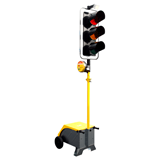Professor Mark Wallace from the Monash University’s Faculty of Information Technology will be discussing possibilities at his upcoming public lecture 'Cheap solutions to the transport problem'.
"The term 'rush hour' is out-of-date. Morning traffic congestion in Melbourne lasts from 6.30am until 9.30am and the annual cost of congestion to Victoria is estimated to rise from $3 billion to $6 billion by 2020," Professor Wallace said.
"An estimated 20,000 trucks move through Melbourne’s inner west each day, and while the East-West Link project – an 18-kilometre inner-urban road connecting the Eastern Freeway and the Western Ring Road – would help reduce this traffic, it will cost $13 billion to complete, with $15 million already spent on writing the business case."
Professor Wallace and his team are exploring ways mathematics can keep traffic flowing on Melbourne’s existing roads and rails.
"Mathematical control of new traffic lights at the M1 freeway entrances has already increased the M1 capacity by 3000 vehicles per hour," Professor Wallace said.
Research shows a new generation of vehicle communication systems, where vehicles provide information to each other such as proximity warnings and where they were heading, would assist with eliminating collisions and enable vehicles to drive faster, and closer together with lower risk.
"A broader vision is to schedule all transport. If drivers notified the transport system each time they started a journey, it could then schedule your road use to balance out traffic across the road system and minimise congestion," Professor Wallace said.
"Simulations show that even with a small percentage of drivers using the system, users could reach their destination in half the time."
The researchers are also proposing the introduction of transfer points for small vans, which account for the majority of freight in Melbourne.
"The transfer points would ensure the vans are used more efficiently and simulations indicate an immediate 25 per cent reduction in the number of vans on the road," Professor Wallace said.
The mathematicians are also developing adaptable bus schemes.
"Public transport take-up in Melbourne is limited because buses are too few and far between," Professor Wallace said.
"However, the development of an adaptable bus scheme that uses communication devices and scheduling algorithms would make sure there’s a bus where and when you need it.
"Mathematics will make it possible to solve Melbourne’s transport problem without the huge costs of new infrastructure. Instead, the costs will be closer to just writing the business case for infrastructure investment."






